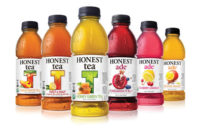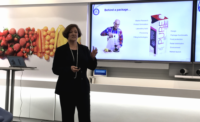Baby boomers want better beverages
As Baby Boomers seek better health through better beverages, makers of juices, teas, coffees and other nondairy beverages create a new generation of drinks that offer flavor, variety and the promise of a new way of life.






The post-World War II baby boom led to a population increase, a need for diversity and a change in cultural identity. Baby boomers (born from 1946 to 1964) have turned into “beverage boomers” who seek a healthy, well-balanced diet and practice a better-for-you lifestyle. These Beverage Boomers are changing nondairy beverages.
The market for dairy-alternative beverages reached $1.33 billion in 2011, according to Packaged Facts. “Almond milk posted the biggest dollar sales gains among all dairy alternative beverages in 2011,” the study says. However, “soymilk remains the most popular type of dairy-alternative beverage primarily because of the health benefits associated with the drink.”
The report also states that “products with flavored, sweetened, unsweetened, low-fat or non-fat, health-specific and fortified varieties are becoming more prevalent in the marketplace.”
That’s why several of today’s milk and beverage processors are reformulating their portfolios to include nontraditional offerings — ones that marry bold flavors with functional attributes, and that are packaged in sustainable, earth-friendly formats. It’s a new generation of drinks.
Generation juice
As baby boomers take control of their health, they pass on their good practices to their offspring, who in turn do the same with their children.
“Consumers are more aware than ever of the impact of beverages on their overall health,” says David Kirkpatrick, chief marketing officer for The FaVe Juice Co. “We have a more educated consumer with ready access to nutritional information and greater awareness of health issues worldwide.”
As a result, companies like the Middletown, N.J.-based processor continue to introduce an array of beverages with healthy attributes. For example, FaVe, an all-natural blend of 100% fruit and vegetable juice, uses a patented process to create juice blends while retaining the flavor. They come in strawberry-banana-kiwi, blueberry-pomegranate-goji and orange-tangerine-pineapple flavors.
“All-natural FaVe relies upon the proven USDA MyPlate Guidelines for daily vegetable servings,” Kirkpatrick says. “FaVe delivers three full vegetable servings in every 8-ounce glass. The benefit of vegetables in our diet is well-established. FaVe also contains only 60 calories in each 8-ounce glass, with no added sweeteners of any kind. This is a dramatic improvement versus existing fruit/vegetable juice blends available today.”
In March, Boulder, Colo.-based GoodBelly debuted Tropical Orange and Pink Grapefruit juice offerings. The drinks add the power of probiotics to a beverage that many people start their day with, says Alan Murray, chief executive officer. “Each product is fortified with 10 billion live and active probiotic cultures per serving, and also offers 100% of the daily recommended value of vitamin C.”
GoodBelly fortifies the drinks with its patented probiotic strain Lactobacillus plantarum299v, said to promote digestive health.
Meanwhile, Brad Armistead, senior marketing director of Naked Juice, Monrovia, Calif., says “consumers have an increased appetite for delicious, yet functional juice options.” The company launched Tropical Mango Probiotic Machine, a 100% juice laden with probiotics. This lactose-free drink comes in a new 15.2-ounce size and is sold nationwide for a suggested retail price of $3.29.
In April, Naked Juice reintroduced its Banana Chocolate Protein Zone smoothie. Available in a 15.2-ounce bottle made of 100% post-consumer recycled plastic, this smoothie offers 16 grams of soy per 8-ounce serving and is a good source of iron and an excellent source of vitamin C and potassium.
Looking for a reprint of this article?
From high-res PDFs to custom plaques, order your copy today!








